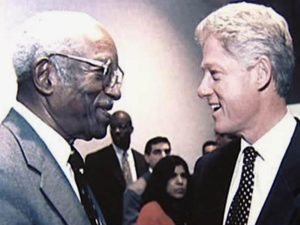Last week I wrote about the importance of the 1990s to current trends in intellectual discourse. Today, I’d like to zero in on one story of the decade: Bill Clinton’s attempt to handle race relations during the 1990s. We would do well to remember how a Southern Democrat, facing a country continuing to wrestle with the legacy of the Civil Rights Movement, navigated the intractable problem of racism in modern life. His 1997 Presidential Commission on Race, which “celebrates” its twentieth anniversary this year, is the best example of how he tried to deal with race. The fact that the commission is virtually forgotten, despite the participation of notables such as historian John Hope Franklin, speaks both to the tumultuous nature of Clinton’s second term, and the nation’s forgetfulness on the recent history of race and American society.
The President’s commission was officially titled, “One America in the 21st Century: The President’s Initiative on Race.” Chaired by Franklin, the commission was designed to bring together Americans of various racial and ethnic backgrounds across the political spectrum. By 1997, the year the commission was brought together, having “conversations about race” was all the rage across America–a pastime, it seems, at which we are particularly adept. This was the era of the “black public intellectual,” when figures such as Cornel West, Michael Eric Dyson, and bell hooks first came to national prominence. Fears from the nationalist Right in the United States also gained national attention. The 1995 Oklahoma City bombing carried out by Timothy McVeigh was influenced by the infamous novel The Turner Diaries by noted white supremacist William Pierce, was merely the high point of national attention being paid to white supremacist militias and other hate groups. Pat Buchanan’s 1992 Republican National Convention speech, which attacked changes in American culture and was given in the aftermath of the 1992 Los Angeles Riots, gave some of these fears a sheen of mainstream acceptance.
Clinton himself, of course, had to worry about keeping African American voters in the Democratic Party’s coalition while also appealing to moderate white voters across the nation. That’s why the language surrounding the commission is fascinating to look at in retrospect. For example, early in the commission’s history the White House took great  pains to make it clear this would not be a “second Kerner Commission.” That reference to the 1967-68 commission on riots and racial violence in the United States was intentional. Clinton’s White House wanted to avoid being tagged as “too liberal.” The Kerner Commission’s analysis—which argued that the nation was moving towards two separate and unequal, communities, and that billions in dollars was needed to rectify these problems—was as inconvenient in 1997 as it was in 1968. Instead the White House argued that this wasn’t “Kerner II” but “Clinton I.”
pains to make it clear this would not be a “second Kerner Commission.” That reference to the 1967-68 commission on riots and racial violence in the United States was intentional. Clinton’s White House wanted to avoid being tagged as “too liberal.” The Kerner Commission’s analysis—which argued that the nation was moving towards two separate and unequal, communities, and that billions in dollars was needed to rectify these problems—was as inconvenient in 1997 as it was in 1968. Instead the White House argued that this wasn’t “Kerner II” but “Clinton I.”
The limits of dialogue about race and racism in American life present in the 1990s constrained what the commission could do from the start. Frustration with President Clinton’s limited goals hurt support from liberals and others to his left. Conservatives were, at best, skeptical of any commission on race and argued it too often left out their viewpoints. At the same time, it is an intriguing look at what some American intellectuals believed would be the important problems of race in the twenty-first century. The final report produced by the commission is an intriguing document, released before the 2000 election, Hurricane Katrina, and the rise of the Black Lives Matter movement. A public commission meeting, chaired by President Clinton, also offers a unique look at the issue of race in the late nineties. For instance, the early discussion about moving the discussion of race away from a black-white binary is incredibly fascinating considering current debates about intersectionality and the racial (and political) polarization of American life.
Future historians, further removed from the 1990s, will likely look at the President’s Initiative on Race as a stepping stone to modern debates about racism in the United States. Thinking about this commission in relation to the Kerner Commission—or, for that matter, African American-run committees such as the Haverford College discussions of 1969—offers an intellectual bridge between the tumult of the late sixties and early seventies to the present. Academics in the late nineties began to look at Clinton’s commission but historians will do much more historicizing of the event in the near future. As historians, we have a critical role to play in reminding the public that “conversations about race” are nothing new in American life. They often take different forms, and use different buzzwords and academic language, but they are always there. What unites these “conversations,” with a few notable exceptions, is an unwillingness to follow up on them with concrete reform. Whenever the next “conversation about race” takes place, American citizens must take dialogue and turn it into genuine, heartfelt action.

0